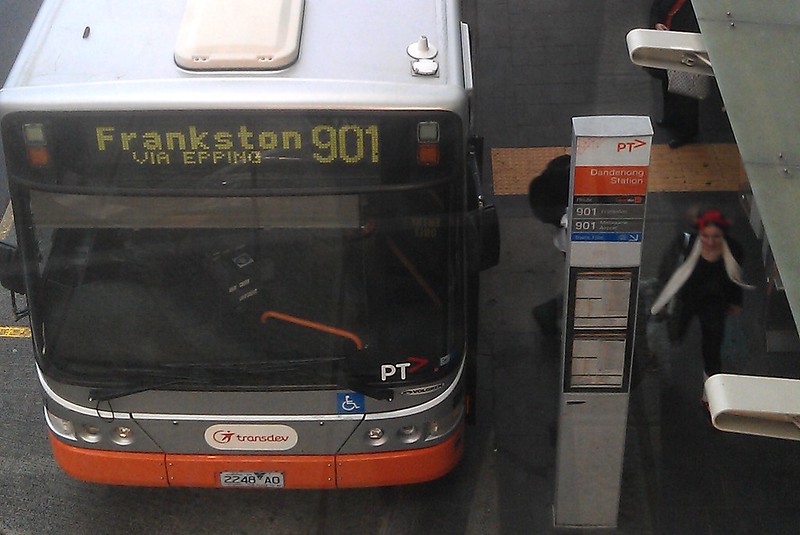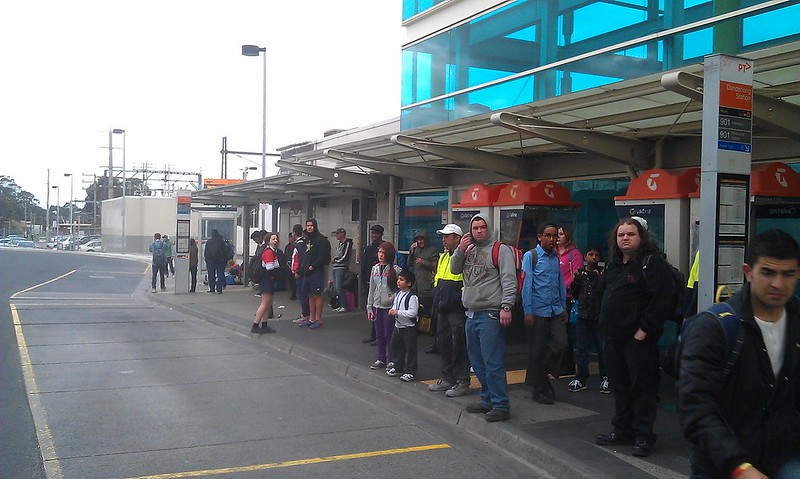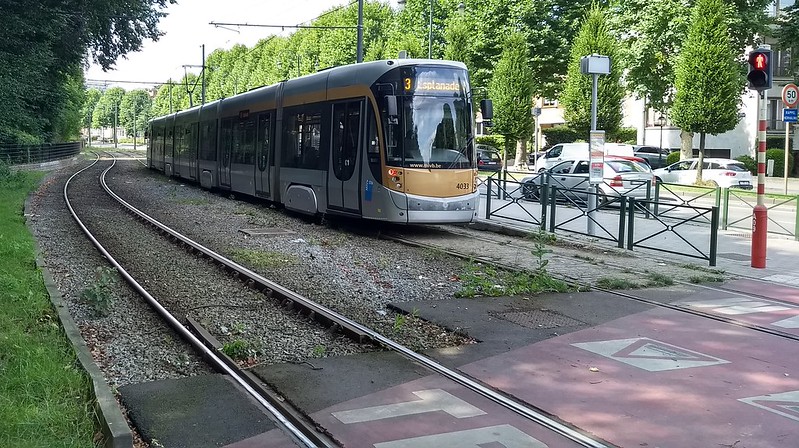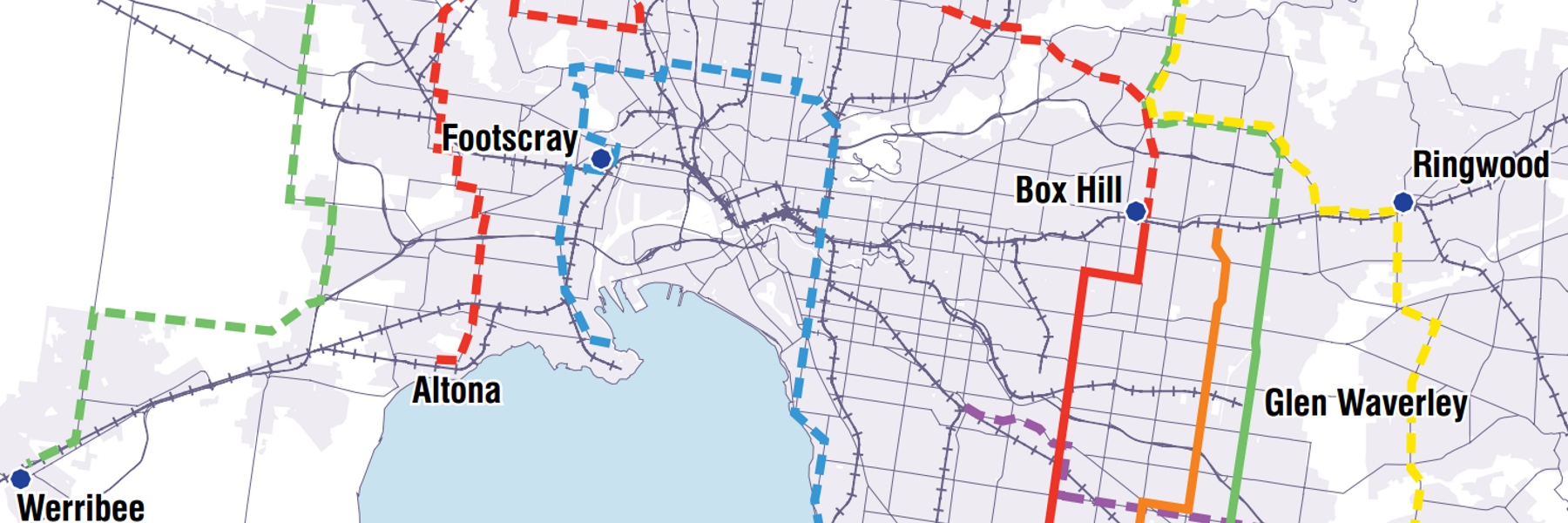One of the promises of the orbital Smartbus routes was to cater for crosstown travel.
The Bracks Government’s 2006 Meeting Our Transport Challenges document said this:
The Government will invest $1.4 billion to create a crosstown transport network for Melbourne. Major new SmartBus routes, supported by improved local bus services, will connect with the rail network to create a grid of radial, arterial and orbital routes within and between suburbs and across the city. For the first time, people living in Melbourne’s middle and outer suburbs will be able to travel across town by public transport without going through the CBD.
I thought I’d test this claim.
The four proposed orbital routes were:
- Yellow Orbital – now the 901 – Frankston, Dandenong, Ringwood, Eltham, Epping to Melbourne Airport
- Green Orbital – now the 902 – Chelsea, Springvale, Nunawading, Eltham, Broadmeadows, Airport West, Sydenham to Werribee
- Red Orbital – now the 903 – Mordialloc, Chadstone, Box Hill, Coburg, Essendon, Sunshine to Altona
- Blue Orbital – proposed as the 904 – Sandringham, Brighton, Richmond, Clifton Hill, Brunswick, Highpoint, Footscray to Williamstown
The Blue Orbital/904 never happened. Arguably the Sandringham end was a bit pointless as it paralleled the railway line, but the rest would have been very handy for orbital trips, saving people time, and relieving demand on the busy inner-city portions of Melbourne’s busiest tram and train routes. The idea is still the subject of campaigning.
The absence of this route is why there’s a gap in the Smartbus numbering – 901 to 903, and the Doncaster routes 905-908 (also flagged in the MOTC document). There’s also the 900 non-orbital Caulfield to Rowville Smartbus route.
And there’s also the 703, which was one of the first Smartbus routes trialled, but was never upgraded to the full Smartbus service level.
The western end of the Green Orbital also never materialised. It stops at Airport West. Parts of the rest are now served by the Regional Rail Link (V/Line service via Wyndham Vale and Tarneit), but the long distances between stations means that is mostly used for longer distance travel. A revamp of local buses at the Werribee end has provided other upgrades.

The Smartbuses have become the busiest bus routes in Melbourne. This is partly due to their length, but also because they offer some of the most frequent services in the metropolitan area – mostly streets ahead of other bus routes.
Did Smartbus deliver on crosstown travel?
So, do Smartbus routes really provide a crosstown trip alternative to going through the inner suburbs/CBD by train?
Here’s how I compared them:
- Compare times from station to station, clockwise, departing at or just after midday on a weekday
- Bus: use Smartbus timetable
- Train: use PTV Journey Planner set to defaults (eg interchange time), except Train only
- Include results for the never-built Blue Orbital, specifically the crosstown sections
So is Smartbus faster than train?
In summary, Smartbus is faster only for short distances.
Here are the results. Bus travel times on the left — highlighted in green where faster, red where slower. Train times on the right. (Click to enlarge)
The 901 runs from Melbourne Airport to Frankston:

The 902 runs from Airport West to Chelsea:

The 903 runs from Altona to Mordialloc:

The proposed 904 (blue orbital) would run from Williamstown to Sandringham, but I’ve focused on the section from Footscray, and assumed if ever implemented it would (like the 246 it would presumably replace) terminate at Elsternwick:

Because this route doesn’t exist, I’ve used the times for the 472 to Moonee Ponds (even though the proposal goes via Highpoint, making it more useful, but taking longer and duplicating the 82 tram and partly duplicating or replacing the 223 bus), the 504 from there to Clifton Hill, then the 246 the rest of the way.
And finally, the 703, the only Smartbus that does not meet the service standard, runs from Blackburn to Brighton:

(*Westbound buses come into North Brighton. They then do a loop, with eastbound buses heading out of Middle Brighton)
What do we learn from these timings?
In general when the trip was one sector, between two neighbouring lines, the bus was faster.
For trips covering one or two segments it varied. Sometimes bus (particularly for trips a long way from the CBD), sometimes train.
For longer trips, it’s usually faster by train, even if the journey is a much longer distance, and even if the train interchange at or near the CBD has you arriving and then departing at a near 90 degree angle. For instance, Sunshine (almost due-west of the CBD) to Coburg (almost due-north) is 61 minutes by bus, but 42 by train.
For the longest crosstown trips, such as Broadmeadows to Frankston, train is the clear winner thanks to its more direct route and inherent speed, with a travel time under half of the bus, which goes the long way around, and may be deliberately (and sensibly) designed to serve traffic generators such as major shopping centres.
Something I haven’t compared is car travel. Even though buses and trains can suffer delays, driving is far more variable. It’s likely to be faster than bus in all cases, and often faster than train outside peak hours — but this is slowly changing. With traffic congestion now increasingly an all-day, all-week affair, train is increasingly competitive for crosstown trips.
I also didn’t look at crosstown tram routes such as the 82 (Footscray-Moonee Ponds) and the 16 (Glenferrie-Malvern-Balaclava). Maybe something for another day. There are also, of course, many crosstown non-Smartbus routes.

Other travel time factors
Train times can be inconsistent where frequencies on the two lines are not aligned. For instance Coburg (every 20 minutes) to Holmesglen (every 15 minutes) came out at either 58, 63 or 68 minutes depending on the precise time of departure. For this exercise I always chose the one at or just after midday – for this case it was 58 minutes, but for others it could be the lowest or highest figure, not the middle.
When I chose midday as the start time, I didn’t realise that for train trips via the CBD, this narrowly avoids traversing the Loop outbound. With a slightly later start time, you might even go around the Loop twice; for instance if you wanted Sunshine to Box Hill, leaving on the 12:24 train from Sunshine, you’d go around the Loop into Flinders Street, just miss a direct Box Hill train, and go around the Loop again on the next departure, arriving at Box Hill at 1:31… which at 77 minutes is still far faster than the bus.
Some of the Smartbuses stop at multiple stations on the same line, for instance the 901 at Blackburn and Ringwood, and also at Kananook and Frankston. These segments are probably most useful for local trips, but some might use them as an alternative route when trains are disrupted.
In peak hour, the results would be even more skewed towards trains. Buses take longer in heavier traffic. Trains on most lines are more frequent in peak, and (particularly on the Hurstbridge, Belgrave/Lilydale and Frankston lines) there are more likely to be expresses.
On weekends and in the evenings, the results are also likely to be more skewed towards trains, because bus frequencies drop off markedly, making the chances of a departure time that’s convenient rather less likely. (Just ask anybody who’s tried to catch a 703 at the Bentleigh/Brighton end of the route after 9pm on a weekday. There aren’t any.)
Anti-clockwise results might be a bit different to clockwise.
Most importantly, individual passengers may or may not prioritise fast travel time over other factors, such as their tolerance for interchange.

Some lessons here
There are various things the authorities can do to make the buses faster.
- On-road priority – bus lanes and jump start lanes and clever traffic light programming which adjusts the sequences to give buses a green rather than a red.
- Limited stops services should also be considered; as an example, the limited stops 900 is about 35% quicker than other routes along Wellington Road. Express services would be even quicker, though there’s a trade-off here; frequency needs to be maintained at the skipped stops.
- Other measures such as all-door boarding (becoming more common around the world), or even off-vehicle ticket validation would also speed up buses.
There’s a limit to what buses can do. It should be recognised that train is inevitably often quicker for longer trips, even when quite indirect, and generally is the mode of Melbourne’s PT network that is most likely to be competitive with car travel. Trains are the backbone of the network, and frequencies need to be boosted to cut connection times, though this is an issue across all modes.
Given buses generally aren’t great for long suburban trips, we shouldn’t feel bad about splitting Smartbus routes to make them more efficient and reliable. Transdev are getting flak for poor performance, but I think (broadly speaking) they had the right idea around splitting the orbital Smartbus routes into separate segments.

Future orbital routes
Looking into the future, improving options to a point where the speed and frequency is competitive on orbital trips could definitely help relieve parts of the radial rail network — for instance, in the past proposals have been made for express buses connecting from Caulfield to the Ringwood lines.
What about orbital rail lines? My sense is that the travel patterns probably don’t warrant heavy rail, particularly beyond the inner suburbs.
But fast efficient off-road light rail or busways might be a good option. If built properly, segregated from traffic, with priority where they cross roads (Brussels has some good examples), they can be very fast, and could be a good middle ground in terms of capacity, while still maintaining good frequency.

Smartbus arguably isn’t a long-distance orbital service anyway
The timings clearly show that Smartbus doesn’t really handle long crosstown trips very well.
But by providing frequent services, they are very valuable for short distance trips, short to medium-length journeys into activity centres, and as rail feeders.
Looking at the big picture, public transport needs a lot of improvement – there are so many journeys where the service offering is simply not competitive.
Catering for orbital journeys is part of this, but there are many other needs, including beefing up capacity and frequency for the far more numerous radial and local trips. Improved connections to/from the rail backbone are also critical.
And in most respects, Smartbus has been proven to be successful. We just need more of them.
- Any errors in my figures? Please leave a comment or send me an email

14 replies on “Smartbus vs train: What’s faster for orbital travel?”
Infrastructure Vic has previously said the 828 and 513 are two priority routes for smartbus. These would be handy indeed.
RE:904. It does irit me that this route has not been introduced, along with the 902 to Werribee. I hope something happens in this budget???? although I doubt it.
RE:Train vs Orbital.
I seem to remember, before the #901, travelling from Dandenong to either Frankston or Ringwood, the train via Caulfield to Frankston or via Richmond to Ringwood, was on par, and at times it seemed quicker than the bus. Going from Ringwood to Frankston, the train via Richmond was almost half the time. I have not checked that with the current #901.
There is no doubt that, Dandenong to Melbourne Airport is much quicker than the 901. Often, Id go Dandenong to Broadmeadows by train, then 901 to the airport. Although last Thursday, I had no choice but to use SkyBus, for a 7am flight. The first train from home did not give me the time for the trip via Broadmeadows this time.
RE:Orbital train route opportunities.
I would argue that, very easy opportunities exist as follows,
++ Extend Alamein line to Oakliegh. You could extend the Camberwell end up to Fairfield too??
++ Newport – Sunshine – Broadmeadows, can be done with diesel rail cars and a new platform at Sunshine.
++ The Eastlink reservation has room for a railway. Can we get non-stop Metro trains between Dandenong and Ringwood as well as Dandenong and Frankston?
++ Is the old inner circle railway worth looking at too?
The Rail Futures Institute are campaigning for a network of trams or light rail routes to provide many of these links.
RE:Smartbus orbital success.
There is no doubt that, they are very popular. The Dart routes had a great increase in passengers, especially in respect to full fare passengers too. The only major change was the PIDS at the stops and on the buses. Saying, such a premium upgrade is sure to pay for itself.
The Orbital routes can be great as tourist sightseeing trips. I have done all three in full not long after their introduction.
They can be great for a number of overlaping short distance travels, such as Dandenong South to the Dandenong Market, or perhaps Doncaster to Northland, and some other trips like that.
Id like to see the #904 introduced, Elsternwick to Williamstown, as well as a #914, Southland to Latrobe Uni replacing most of 600 and 246.
In place of extending #902 to Werribee, I would prefer something that is Sunbury – Airport – Airport west – then to Werribee as to the #902 plans. The regional rail link is never meant to be used for local travel. The bus however, should do that well.
Something that runs, Frankston, Cranbourne, Narre Warren, Belgrave, Lilydale or Croydon, Diamond Creek would be of great value too.
While we wait for a train, an express via freeway bus routes from Dandenong to Frankston and Ringwood. Perhaps Frankston to Ringwood also.
There needs to be a great focus on bus only lanes wherever possible, to ensure those little auto-mites do not block its way.
“On weekends and in the evenings, the results are also likely to be more skewed towards trains, because bus frequencies drop off markedly, making the chances of a departure time that’s convenient rather less likely.”
Yes and no. There’s other factors at play here. Weekend day times have very different characteristics to evenings. And weekday, Saturday and Sunday evenings are each very different from one another. Due either to service characteristics or road conditions.
* Weekend day times (middle of day): Train frequency is better (10 or 20 min) compared to SmartBus frequency (30 min typical). Road traffic volumes also favour train. Train wins more times than average.
* Early Sunday mornings: train frequency (30 – 60 min) is more variable than SmartBus frequency (30 min). Waits for outbound trains may be increased as they don’t reach their full daytime frequency until 10-11am. SmartBus starts quite early on weekend mornings and quiet roads favour bus speeds. Bus wins more times than average. Foregoing sometimes applies early Saturday mornings.
* Weeknights: Train frequency (20 – 30 min) can mean significant waits and high variability if incompatible as can happen in the 8-10pm period. SmartBuses have approx 15 min frequency until 9pm which beats trains on most lines in early evening. Road congestion should have abated but there may still be reliability issues in early evening due to recovery from pm peak.
* Saturday nights: Train and SmartBus frequency both the same (30 min) with train running all night. Transfer penalties may be high. due to low frequency and higher if cold. Good road travel speeds benefit bus. SmartBus wins more than average unless you leave it too late.
* Sunday nights. SmartBus finishes 9pm so train wins unless leaving early.
I think one issue some didn’t like about proposal to split orbitals was some of the cuts in north & west. Though at time proposal had at no cost hence other routes elsewhere also had cuts proposed.
Splitting routes can improve reliability but still need make sure run times and layover is realistic. If run time is too short or hardly any layover time then still be issues.
Though these runs can get many delays none of them bar 901 have ever made it into top 5 worst performing Transdev. Probably due to fact least got some priority and don’t run near city where delays on some can be major and quit erratic in nature.
These orbital or cross-regional type of routes are not intended to be ridden from end to end (except by transport enthusiasts!), but are patronised in overlapping segments where a commuter may obtain a faster journey than by the train system (which invariably in Australia involves a radial trip into the CBD then out again via another line).
The commuter themselves (with the assistance of the journey planner) will evaluate which mode, or combination of modes, yields him or her the fastest and most convenient journey. So there are many possible combinations of segments of the route used by commuters (though there are usually more heavilty-used, predictable segments along a route), thus the route needs to be continuous, without interchange, to cater for all the segments in a way that optimally convenient for the commuter.
An interesting complete orbital route is the 998/999 in Perth which takes about 3.5 hours to complete a circuit from Fremantle to Fremantle, where there is a layover out of necessity for the poor driver to take a break! So the only “inconvenience” in that route is that it’s not possible to travel through Fremantle without changing buses. However, in my experience, the buses keep their timetable remarkably well considering the journey time and traversing much of the Perth metropolis! Transperth seems generally very adept at fine-tuning bus schedules to predictable levels of traffic at different times of day.
There usually isn’t the traffic to justify orbital train lines, though there are some here and there in Australia and Perth is setting out to build, in stages, a complete orbital line.
I think the bottom line for the commuter to get the most out of orbital-cross-regional services is use of the journey planner. That should tell you the quickest trip by whatever combination of modes (assuming that they’re all running to timetable!).
Another informed and useful piece of analysis – thanks.
One thing to bear in mind is that trains on some lines (like Sandringham) run only every 20 minutes in off peak and weekends. So a theoretical 35 minutes PT journey can take 50 minutes. This also makes using the car look more favourable.
May I second Roger’s praise? An excellent post, Daniel!
I’ve thought about doing a similar exercise to see which trips between neighbouring lines would be quicker by bus, not just for the 90x orbitals.
The Sunshine to Coburg example is interesting. The orbital probably covers the same distance as the train. And in fact a train/tram (i.e. Sunbury & 19 tram) will still marginally beat the orbital, as will just cycling. The train should win hands down – 30 minutes actual travel time (half the bus), but you have to wait 12 minutes for the connection at North Melbourne. If there was a 10-minute frequency, that’s cut to 2 minutes, and a 32-minute trip all up. Right at the moment, with no traffic, the car would beat it (23 minutes).
And RRL gives a faster orbital trip from Sunshine to Werribee – 53 minutes via Footscray, but only 42 minutes via Tarneit then bus. Although not in the opposite direction. Again, it’s the connection time that adds to the journey – 13 minutes waiting at Footscray, which could be cut to 3 (although that might not be enough to change platforms).
I think segregated orbital light rail is the way to go, but as you rightly point out, they’ll only be used for short trips. So there doesn’t need to be a mania about making the loop complete from the start, which appears to be hampering the Orbital Smartbuses because the less busy sections get as many services as the really useful sections.
Some clever, segregated, local connections could boost the overall transport network and help improve movement around the city.
Completely orbital is not really the way to go either, the pull is always towards the centre of the city, so it would be more like bowed connections between nodes taking people from outer suburbs laterally and towards the centre in most cases.
Something like extending the 75 tram from Knox to Rowville then back to Monash Uni would be easily built, faster and get more use than the SmartBuses on this route (which are already quite busy).
Some of the trips faster by train leaving just after 12noon, would be faster by bus leaving just after 2pm because there are still extended morning peak-shoulder express trains on the Belgrave/Lilydale line at 12noon. Conversely, some of the trips that are faster by bus leaving just after 12 noon, would be faster by train at 11 am because the first train from those stations to Flinders St does not reach its destination in time for the last express at 12:26pm.
Orbital rail, like the smart buses, would derive most of their patronage from more localised trips than genuinely orbital ones. The most pressing case for orbital rail is thus extending the Alamein line to Oakleigh, via East Malvern and Chadstone.
Maybe Melbourne could have bus lanes?
“clever traffic light programming which adjusts the sequences to give buses a green rather than a red.”
I have said for a few years now that buses/trams/ambulances should be allowed to control the traffic lights. For decades, pedestrians have been able to control the traffic lights by pressing a round button!
Just about every phone has a GPS antenna these days, so just install an app on a smartphone and that app shall use GPS to see where the bus is and then connect to the VicRoads HQ and request that certain lights be made green for the bus. The phone would be carried by the bus driver.
I was at Dandenong station on Monday and noticed that the overpass provides complete protection from the rain – unlike the new overpasses at Coolaroo and Roxburgh Park. The same thing ought to be provided at those newer stations. Even if the glass is sandwiched between 2 layers of mesh. Vandals should be jailed – I bet it is the same ratbags doing it again and again.
Pedestrian buttons have little to no effect on intersection traffic lights, other than changing the pedestrian lights. They actually are harmful to pedestrians` interests because they mean that cycles that would otherwise have green pedestrian phases do not because the button was not pressed in time.
Glass sides for footbridges, stairways and escalators are a good idea, provided there is adequate ventilation. We do not want to create glasshouses.
[…] support a more polycentric city, which makes a lot of sense, enabling cross-suburban trips in a way that Smartbuses don’t quite manage, and help Melbourne develop more jobs not just its CBD and inner suburbs, but across the greater […]